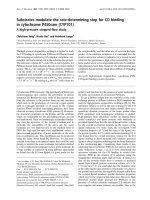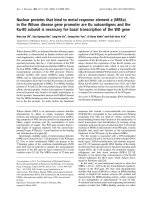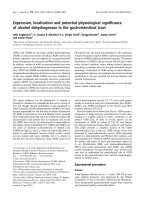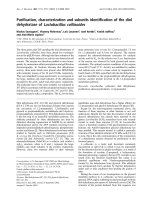Báo cáo y học: "Ultrasound has the potential to detect degeneration of articular cartilage clinically, even if the information is obtained from an indirect measurement of intrinsic physical characteristics" pdf
Bạn đang xem bản rút gọn của tài liệu. Xem và tải ngay bản đầy đủ của tài liệu tại đây (42.46 KB, 2 trang )
Available online />Page 1 of 2
(page number not for citation purposes)
We appreciate the concern shown by Zheng and Huang [1]
regarding our earlier article [2]. We presented simple data
showing that the ultrasound response of articular cartilage
may be related to its International Cartilage Repair Society
grading, and concluded that ultrasound evaluation using the
signal intensity – dependent on the ultrasound reflection
coefficient at the cartilage surface – may be helpful to
differentiate International Cartilage Repair Society grades,
especially grade 0 from grade 1 cartilage [2].
Our ultrasound system obtains indirect information on
intrinsic physical characteristics of living human articular
cartilage in vivo. We recognize that the ultrasound signal
intensity of articular cartilage relates to the parameters of the
tissue reflection coefficient, acoustic impedance, the elastic
modulus, and surface conditions. In clinical settings, however,
these parameters are difficult to measure separately. We
therefore consider that the signal intensity obtains information
including these parameters.
We do not disregard measuring the intrinsic physical charac-
teristics. Indeed, the signal intensity (maximum magnitude)
correlated significantly with the aggregate modulus of
articular cartilage [3]. We mentioned the equations of Young
modulus, indicating the speed of sound, the density of a
material, and the acoustic impedance of a material [4], and
presented the Gabor function as the mother wavelet and
equations [2]. The signal intensity did not depend on the
surface curvature for radii >40 mm, and mainly reflects the
condition from the surface of the cartilage to a depth of one
wavelength (about 0.150 mm) [5]. The tip of the probe with
an ultrasonic transducer is designed to achieve uniform
distance between the transducer and the cartilage surface.
Our ultimate goal is not to measure the intrinsic physical
characteristics but to improve the diagnostic use of an
arthroscopic ultrasound system and the method to detect the
early stage of degeneration of human articular cartilage. The
signal intensity, considering tissue histology [4] and
estimation of the mechanical property of meniscus [6], was
studied aiming toward human clinical study [7]. Our ultra-
sound system can be used with the arthroscopic probe and
can obtain information on the degeneration of human articular
cartilage in vivo.
It is not easy to calculate the intrinsic physical characteristics
from an ultrasonic echo obtained under arthroscopy. True it is
ideal that the intrinsic physical characteristics of cartilage are
measured accurately, but this is still difficult in clinical
settings using existing devices. The authors consider that
weakness to measure the intrinsic physical characteristics
accurately does not interfere with our final purpose; that is,
quantitative evaluation of human cartilage in clinical settings
such as arthroscopy.
Finally, information on the signal intensity is valuable for
clinicians who want to know the mechanism of degeneration
of cartilage without performing a tissue biopsy. Until an ultra-
sound system that can measure the intrinsic physical charac-
teristics of human cartilage in vivo is developed, we believe
Letter
Ultrasound has the potential to detect degeneration of articular
cartilage clinically, even if the information is obtained from an
indirect measurement of intrinsic physical characteristics
Hiroshi Kuroki
1
, Yasuaki Nakagawa
2
, Koji Mori
3
, Masahiko Kobayashi
4
, Ko Yasura
4
,
Yukihiro Okamoto
4
, Takashi Suzuki
4
, Kohei Nishitani
4
and Takashi Nakamura
4
1
Division of Motor Function Analysis, Department of Physical Therapy, Human Health Sciences, Graduate School of Medicine, Kyoto University, Kyoto,
606-8507, Japan
2
Department of Orthopaedic Surgery, National Hospital Organization Kyoto Medical Center, Kyoto, 612-8555, Japan
3
Department of Applied Medical Engineering Science, Graduate School of Medicine, Yamaguchi University, Ube, Yamaguchi, 755-8611, Japan
4
Department of Orthopaedic Surgery, Graduate School of Medicine, Kyoto University, Kyoto, 606-8507, Japan
Corresponding author: Yasuaki Nakagawa,
Published: 24 June 2009 Arthritis Research & Therapy 2009, 11:408 (doi:10.1186/ar2727)
This article is online at />© 2009 BioMed Central Ltd
See related research by Nakagawa et al., and related editorial by Zheng and Huang,
/>Arthritis Research & Therapy Vol 11 No 3 Kuroki et al.
Page 2 of 2
(page number not for citation purposes)
that the ultrasound information our technique provides will
help clinicians to understand degeneration of articular carti-
lage – even if the information is obtained from an indirect
measurement of the intrinsic physical characteristics.
Competing interests
The authors declare that they have no competing interests.
References
1. Zheng YP, Huang YP: More intrinsic parameters should be
used in assessing degeneration of articular cartilage with
quantitative ultrasound. Arthritis Res Ther 2008, 10:125.
2. Kuroki H, Nakagawa Y, Mori K, Kobayashi M, Yasura K, Okamoto
Y, Suzuki T, Nishitani K, Nakamura T: Ultrasound properties of
articular cartilage in the tibio-femoral joint in knee
osteoarthritis: relation to clinical assessment (International
Cartilage Repair Society grade). Arthritis Res Ther 2008, 10:
R78.
3. Mori K, Hattori K, Habata T, Yamaoka S, Aoki H, Morita Y,
Takakura Y, Tomita N, Ikeuchi K: Measurement of the mechani-
cal properties of regenerated articular cartilage using wavelet
transformation. In Tissue Engineering for Therapeutic Use 6.
Edited by Ikada Y, Umakoshi Y, Hotta T. Tokyo: Elsevier;
2002:133-142.
4. Kuroki H, Nakagawa Y, Mori K, Ohba M, Suzuki T, Mizuno Y, Ando
K, Takenaka M, Ikeuchi K, Nakamura T: Acoustic stiffness and
change in plug cartilage over time after autologous osteo-
chondral grafting: correlation between ultrasound signal
intensity and histological score in a rabbit model. Arthritis Res
Ther 2004, 6:R492-R504.
5. Mori K, Nakagawa Y, Kuroki H, Ikeuchi K, Nakashima K, Nime T,
Nakamura T, Kawai S, Saito T: Non-contact evaluation for artic-
ular cartilage using ultrasound. JSME Int J Ser A 2006, 49:
242-249.
6. Yasura K, Mizuno Y, Nakagawa Y, Mori K, Takenaka M, Ohashi T,
Yamada K, Kobayashi M, Ando K, Kuroki H, Suzuki T, Ikeuchi K,
Tsutsumi S, Nakamura T: Estimation of the mechanical prop-
erty of meniscus using ultrasound: examinations of native
meniscus and effects of enzymatic digestion. J Orthop Res
2007, 25:884-893.
7. Nishitani K, Nakagawa Y, Gotoh T, Kobayashi M, Nakamura T:
Intraoperative acoustic evaluation of living human cartilage of
the elbow and knee during mosaicplasty for osteochondritis
dissecans of the elbow: an in vivo study. Am J Sports Med
2008, 36:2345-2353.









